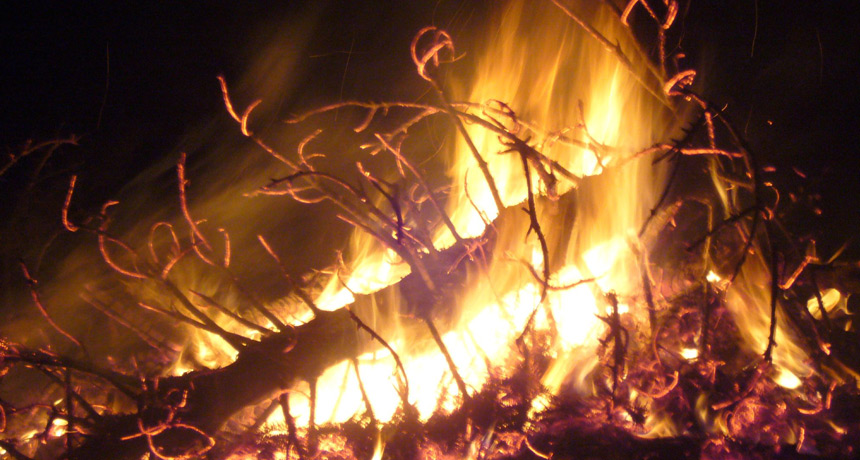Teen gets fired up about Christmas tree safety
A dry Christmas tree can become dangerous fire fuel

A dry Christmas tree makes great fuel for a fire.
Orin Zebest/Flickr (CC-BY 2.0)
Share this:
- Share via email (Opens in new window) Email
- Click to share on Facebook (Opens in new window) Facebook
- Click to share on X (Opens in new window) X
- Click to share on Pinterest (Opens in new window) Pinterest
- Click to share on Reddit (Opens in new window) Reddit
- Share to Google Classroom (Opens in new window) Google Classroom
- Click to print (Opens in new window) Print
WASHINGTON, D.C. — The news story of a tragic Christmas tree fire in Annapolis, Md., stunned many people in January 2015. Sienna Fink didn’t just read about the tragedy and move on, though. That house fire — which killed four children and their grandparents — deeply affected her. She began to wonder if other families might also be at risk. To probe the issue, she fire-tested pine branches. That research showed that even a week out of water makes those evergreens far more flammable.
Sienna, 14, is now a freshman at Eastern Technical High School in Essex, Md. And that tree-burning research garnered her a finalist’s spot, here, at the 2016 Broadcom MASTERS competition.
MASTERS stands for Math, Applied Science, Technology and Engineering for Rising Stars. The competition was created by Society for Science & the Public — which publishes Science News for Students and this blog. It’s sponsored by the Broadcom Foundation. Every year, this event brings together 30 middle-school science-fair winners from around the country. They compete in team challenges and show off their research projects.
People often bring a live tree into their home to supply some Christmas cheer. But to slow its drying out, they need to water it often. In the rush of the holiday season, many forget. “A lot of people have [their tree] out of water for quite a while,” Sienna says. “They don’t think it’s very important.” But a dry Christmas tree can catch fire. There were 210 such fires in in the United States in 2014, according to the National Fire Protection Association. And in one out of every 31 Christmas tree fires, someone dies, according to the U.S. Fire Administration.

Sienna wanted to find out the effect of watering the trees on their risk of going up in flames. She thought about setting whole Christmas trees on fire. Then she consulted with Isaac Leventon. He studies fire protection at the National Institute of Standards and Technology in Gaithersburg, Md. Leventon explained that igniting whole trees was far too dangerous for her or any non-expert. (Even fire experts do this only after taking extensive safety measures.)
So the teen trimmed back her experimental design and focused on a pine tree in her backyard. She cut 18 branches from the tree, each 46 centimeters (18 inches) long. She divided the branches into six groups of three.
She took one group of branches and stuck their cut ends in buckets of water for six weeks. The remaining groups stayed in a bucket of water for only one to five weeks. After branches left the water, each hung high and dry in her basement until the end of the six-week mark.
Flaming out
Sienna hypothesized that branches that had lost the most moisture would burn most readily. To test this, she took one branch from each group and weighed it. Then she baked that branch in her oven at 93° Celsius (200° Fahrenheit) for four hours. This let all of the water in the branch evaporate. Afterward, Sienna weighed each branch again. By subtracting the weight of the baked branch from its pre-oven weight, she calculated how much mass had been lost. That lost mass equaled the moisture content of the pre-baked branch.
A branch that had been in water for six weeks was 50.8 percent water (by mass) prior to baking. One that spent a week dry was 24.4 percent water. The branch that had been out of water for five weeks was a dried-out stick — just 7.9 percent water.
Sienna then set up a test to see how quickly a branch would ignite when exposed to a flame. She used a pulley system to hoist the remaining two branches from each group over a metal fire pit in her backyard, one branch at a time. Inside the fire pit was a burning can of jellied alcohol fuel (you may have seen one under a pot of melted cheese or chocolate). Sienna lowered each branch to just 1 centimeter (0.4 inch) above the flame. She used a stopwatch to find out how long it took each branch to catch fire.
The pulley system kept the teen far away from the flames. Still, Sienna points out, “my dad was there with a fire extinguisher in case anything went wrong.”
Branches that sat in water for six weeks were moist. It took a full 31 seconds for them to catch fire. Those that sat in water a week less caught fire much faster, in just 10.5 seconds. And after five weeks out of water, the branches caught fire in 0.74 second. The drier branches also burned to a crisp much more quickly than well-watered ones. Those out of water for two to five weeks flamed out in two minutes or less. The constantly watered branches didn’t want to ignite at all. Once they did, they simply smoldered for almost four minutes.
Sienna shared her findings here at the Broadcom MASTERS public day, October 30.
A well-watered Christmas tree is safest, Sienna concludes. “You need to constantly keep your tree in water,” she says. “It…will really affect how quickly it catches [fire] and if it will burn at all.”
The teen’s science fair project also made her very wary around Christmas trees. “I don’t like having real Christmas trees anymore in my house,” she says. “I know how dangerous it is.” She’s still trying to convince her family to buy a fake tree.
Follow Eureka! Lab on Twitter